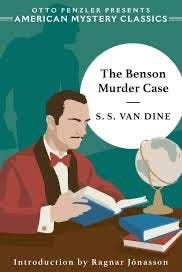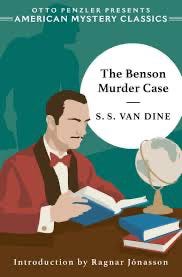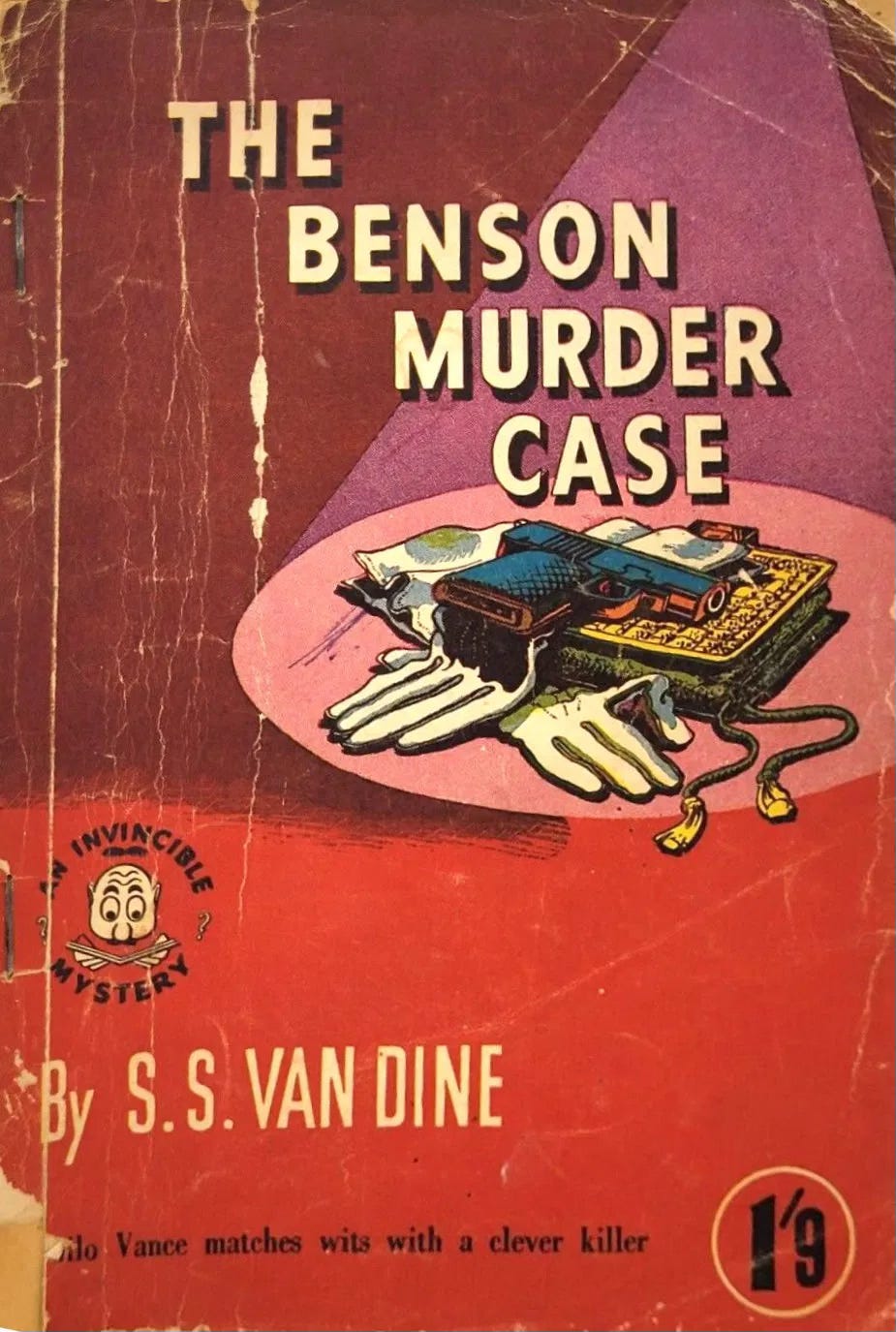The Benson Murder Case by S. S. Van Dine
in which i explore the case against van dine and his detective
S. S. Van Dine, the pen name of art critic Willard Huntington Wright, published his first detective novel, The Benson Murder Case, in 1926, introducing the world —for better or worse— to art connoisseur and amateur detective Philo Vance. The novel, about the murder of a coldhearted financier (is there any other kind?), was a commercial success and was followed by eleven more mysteries featuring Vance and narrated by “Van Dine,” the fictional narrator who is Vance’s personal lawyer and best friend.
Van Dine the author is a polarizing figure among detective fiction aficionados, either loved for the intricacy of his plots or loathed for the obnoxiousness of his detective hero.
I’m afraid that I fall into the latter category. This one was a real slog, guys. For every interesting, relevant digression Vance makes (Like this one, on the effect of psychology on our actions: “Every human act — no matter how large or how small — is a direct expression of a man’s personality and bears the inevitable impress of his nature… And just as no two faces are exactly alike, so no two natures are exactly alike: the combination of ingredients which make up our personalities varies in each individual. That is why, when twenty artists, let us say, sit down to paint the same subject, each one conceives and executes it in a different manner.”), he says something bananas insulting. (Of the housekeeper: “She seemed, however, to possess that taciturn shrewdness that is so often found among the ignorant.” You don’t say.)
Worse than the condescending smugness permeating ever page are the endless descriptions. Below is Van Dine’s description of District Attorney Markham, who invites Vance into the investigation:
Markham was a tall, strongly-built man in his middle forties, with a clean-shaven, somewhat youthful face which belied his uniformly grey hair. He was not handsome according to conventional standards, but he had an unmistakable air of distinction, and was possessed of an amount of social culture rarely found in our latter-day political office-holders. Withal he was a man of brusque and vindictive temperament; but his brusqueness was an incrustation on a solid foundation of good breeding, not — as is usually the case — the roughness of a substructure showing through an inadequately superimposed crust of gentility.
When his nature was relieved of the stress of duty and care, he was the most gracious of men. But early in my acquaintance with him I had seen his attitude of cordiality suddenly displace by one of grim authority. It was as if a new personality —hard, indomitable, symbolic of eternal justice— had in that moment been born in Markham’s body. I was to witness this transformation many times before our association ended. In fact, this very morning, as he sat opposite to me in Vance’s living-room, there was more than a hint of it in the aggressive sternness of his expression; and I knew that he was deeply troubled over Alvin Benson’s murder.
Every character gets a description like that. EVERY CHARACTER. Actually, there is an exception: Van Dine barely describes the murdered man’s housekeeper (aside from the insults). Her description is so brief I was sure it was some kind of clue. Turns out he just can’t be bothered to describe the help.
It’s not just people. Every new location gets a detailed description whether it’s warranted by the plot or not. Not to keep picking on Markham (But also, why not? He’s kind of a dud.), when Vance and Van Dine meet him at his office, we are subjected to a multi-paragraph description of the space and none of it matters.
The office, like the building, breathed an air of former days. Its high ceilings, its massive golden-oak woodwork, its elaborate low-hung chandelier of bronze and china, its dingy bay walls of painted plaster, and its four high narrow windows to the south— all bespoke a departed era in architecture and decoration.
On the floor was a large velvet carpet-rug of dingy brown; and the windows were hung with velour draperies of the same color. Several large comfortable chairs stood about the walls and before the long oak table in front of the District Attorney’s desk. This desk, directly under the windows and facing the room, was broad and flat, with carved uprights and two rows of drawers extending to the floor. To the right of the high-backed swivel desk-chair, was another table of carved oak. There were also several filing cabinets in the room, and a large safe. In the center of the east wall a leather-covered door, decorated with large brass nail-heads, led into a long narrow room, between the office and the waiting-room, where the District Attorney’s secretary and several clerks had their desks. Opposite to this door was another one opening into the District Attorney’s inner sanctum; and still another door, facing the windows, gave on the main corridor.
I wish I could tell you that any of this — the safe, the desks, the multiple doors — had any bearing on the plot. But no. He’s just setting the scene. People come and go, sit and talk, but where they position themselves in the room simply never comes into play. Compare the above to a description from a series about another famously eccentric detective: Rex Stout’s description of Nero Wolfe’s brownstone. This was taken from Champagne for One:
He was scowling at me. It wasn’t so much that he would have to leave his chair and walk to the hall and on to the alcove, and stand at the hole —after all, that amount of exercise would be good for his appetite— as it was that the very best that could come of it, getting a client, would also be the worst, since he would have to work. He heaved a sigh, not letting it interfere with the scowl, muttered, “Confound it,” put his palms on the desk rim to push his chair back, and got up and went.
The information is so beautifully integrated into the action that you don’t even notice you’re absorbing the layout of the space. It’s a classic case of show, don’t tell, and Van Dine tells us every time.
None of this would be a deal-breaker if Vance wasn’t such a pompous twit. He brags that he knows the identity of the guilty party within moments of his arrival at the crime scene. Instead of letting his friend, THE DISTRICT ATTORNEY OF NEW YORK, in on his thought process, he lords it over him, claiming he’s trying to save Markham from himself. With friends like these, etc., etc.
Van Dine, a highbrow’s highbrow, was embarrassed by the success of his literary slumming, though for all the wrong reasons. There’s much to be embarrassed about —the pedantry, the officiousness, the fawning adoration his fictional counterpart shows for Vance — but Van Dine was embarrassed because he thought the genre was beneath him. Whether they started to notice they were being condescended to or they began to find Vance’s smug schtick exhausting, by the mid-1930s, readers began to tire of Vance, a sentiment famously summed up by Ogden Nash:
Philo Vance Needs a kick in the pance.
Hard to disagree with him.
Further Reading/Viewing
For a more generous take on Van Dine, check out this post from Tipping My Fedora
Philo Vance was immortalized on screen many times, most famously by the dapper and charming William Powell in four films, including The Benson Murder Case (1930), directed by Frank Tuttle, which significantly alters the plot but improves upon Sergeant Heath by having him played by the inimitable Eugene Pallette.
Read with me
I publish on Tuesdays, alternating between short stories and novels.
Next week: “The Hunt Ball” by Freeman Wills Crofts
In two weeks: Speedy Death by Gladys Mitchell







